Category: Gallery
music tower – junelee

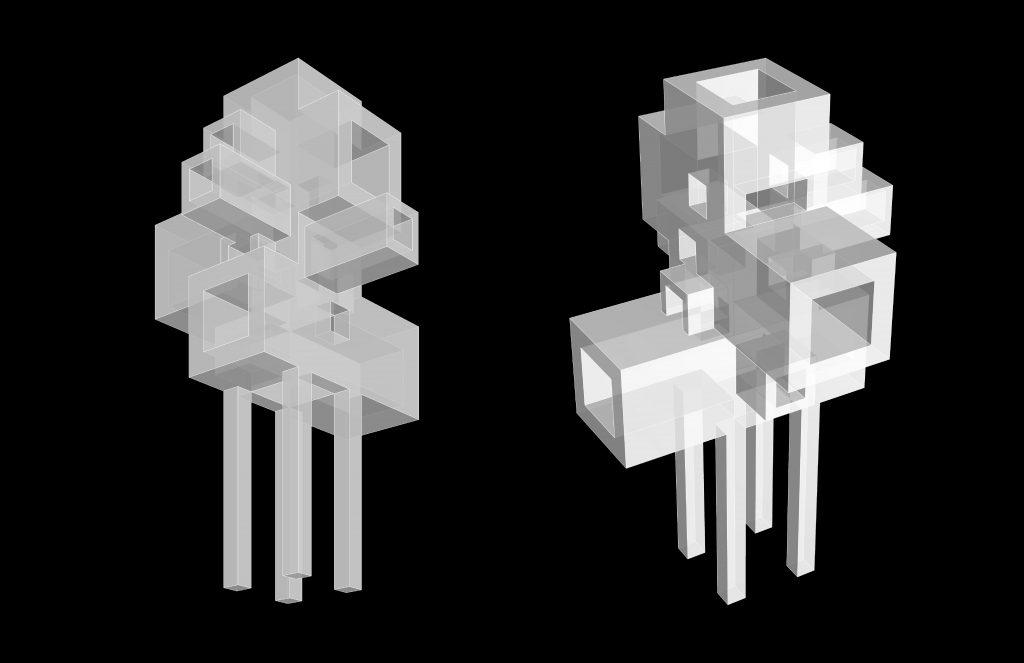
I was inspired by how sound would travel through for an event happening under the music tower. I wanted the tower to physically juxtapose how sound would look or feel like, but still be efficient in spreading sound throughout. To construct this, I constructed a tall, rectangular tower with an open ground and ceiling, capped by all four sides. rectangular prisms make up the four sides as they cross and connect to create holes on an higher altitude.
push / pull objects (3) – junelee
For these three objects, I aimed to create large scale versions of everyday objects such as an egg, peas in a pod, and a button. My focus in making these objects were to try out various techniques and to improve my hand sewing skills.

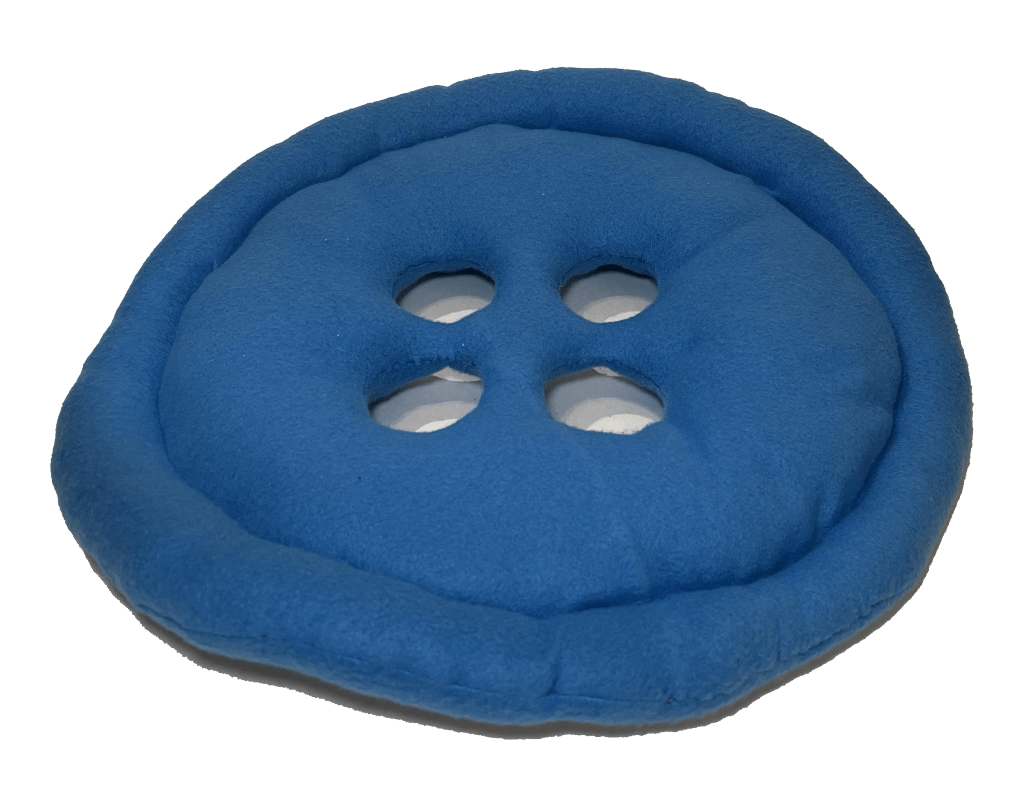

egg
I started the egg by drawing and cutting the white and yolk of the egg separately. I stacked two layers of white acrylic fabric on top of each other and drew a fried egg shape and pinned them together. I sewed the two white fabrics shut with a five inch opening for the last step of filling the egg.
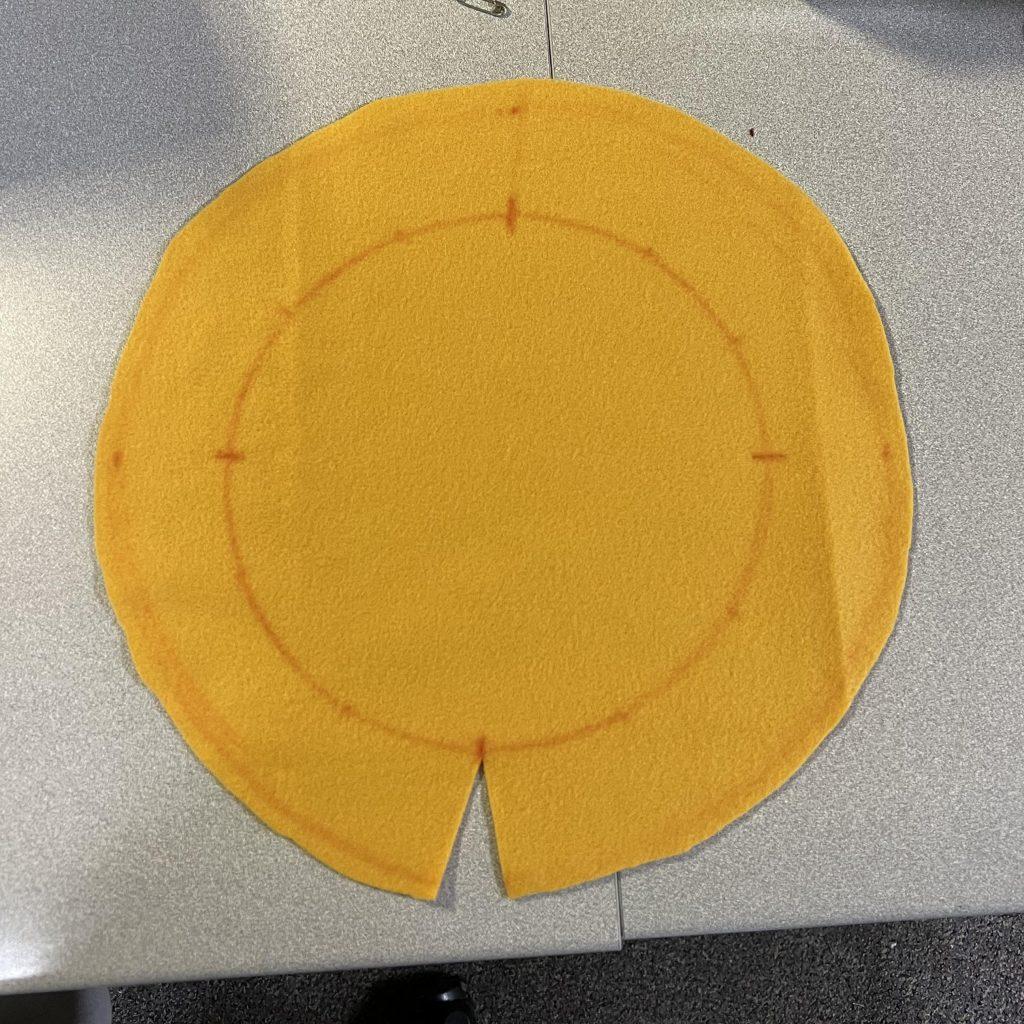
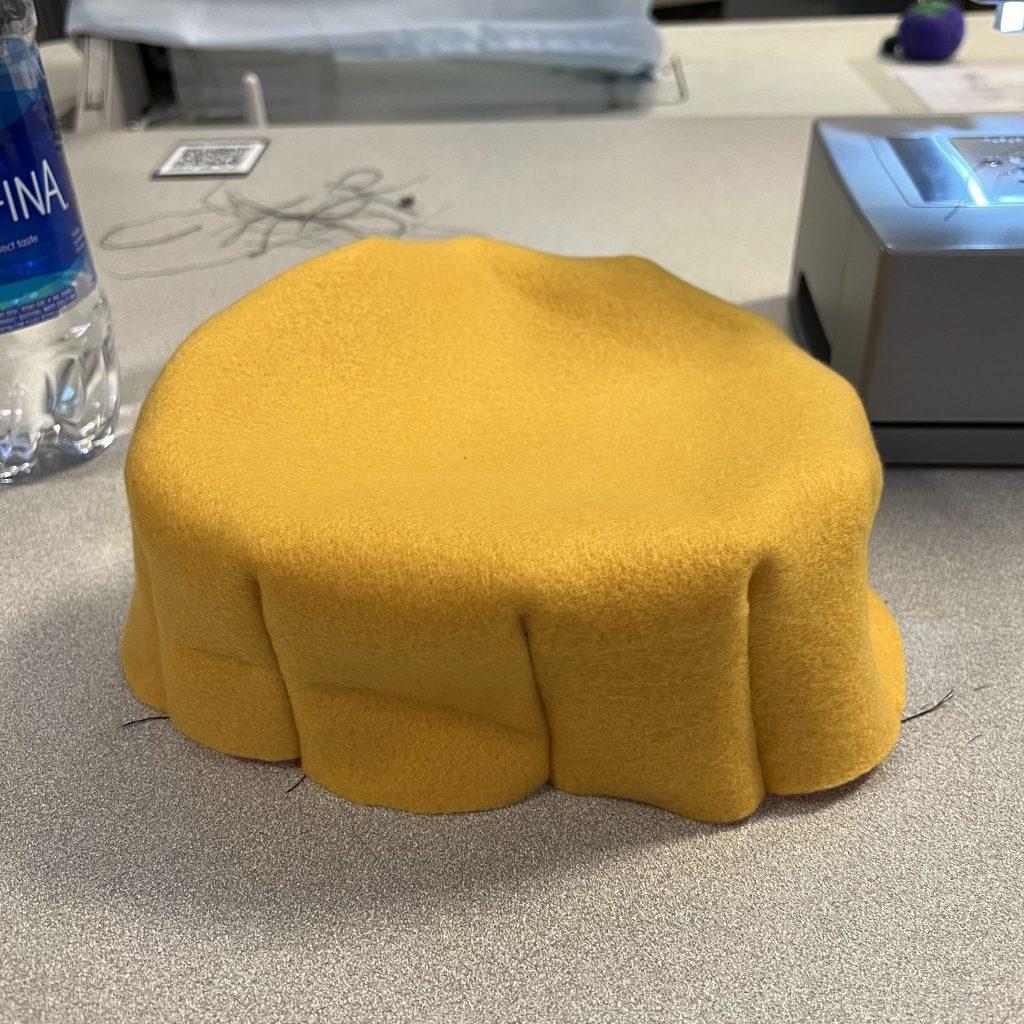

Next, I cut a circle on the top layer for the yolk to go on top. I drew two concentric circles on the yellow yolk fabric: the outer as the sew line onto the top white layer and the inner circle as the circumference of the protruding yolk. To make the protrusion of the yolk, I folded the fabric and sewed on the inside 12 times to create a cylinder-like shape. To attach the yolk to the white, I flipped the white fabric inside out and attached the bottom of the yolk to the circle hole on the top white fabric.
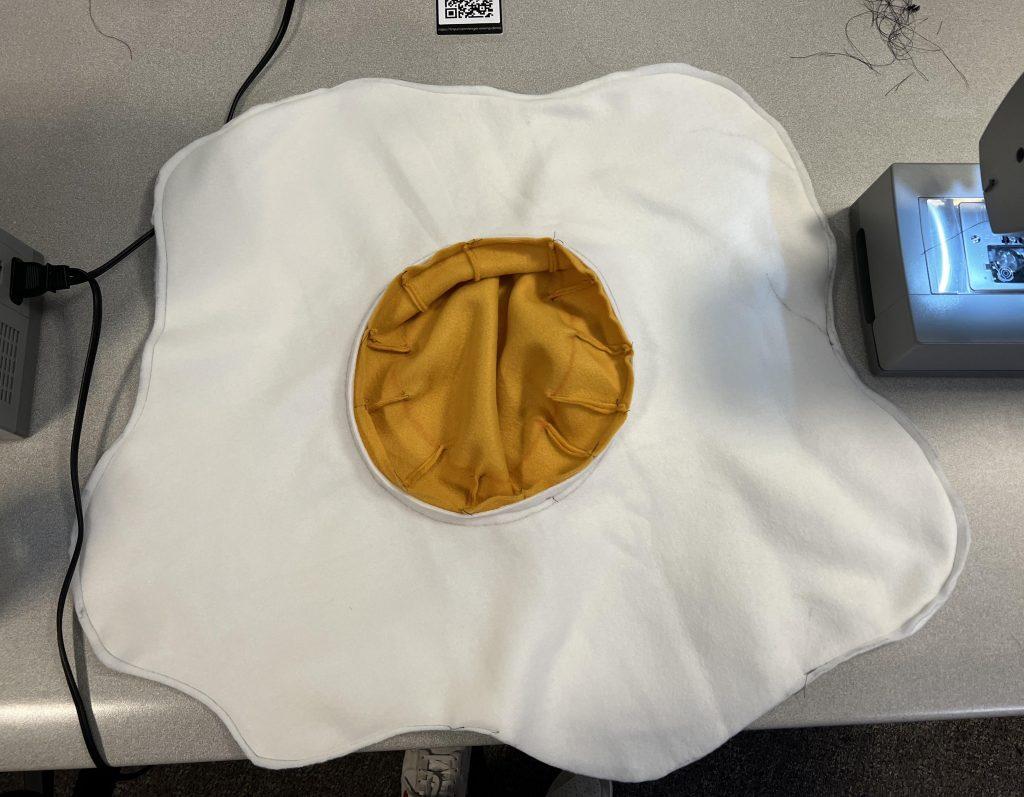
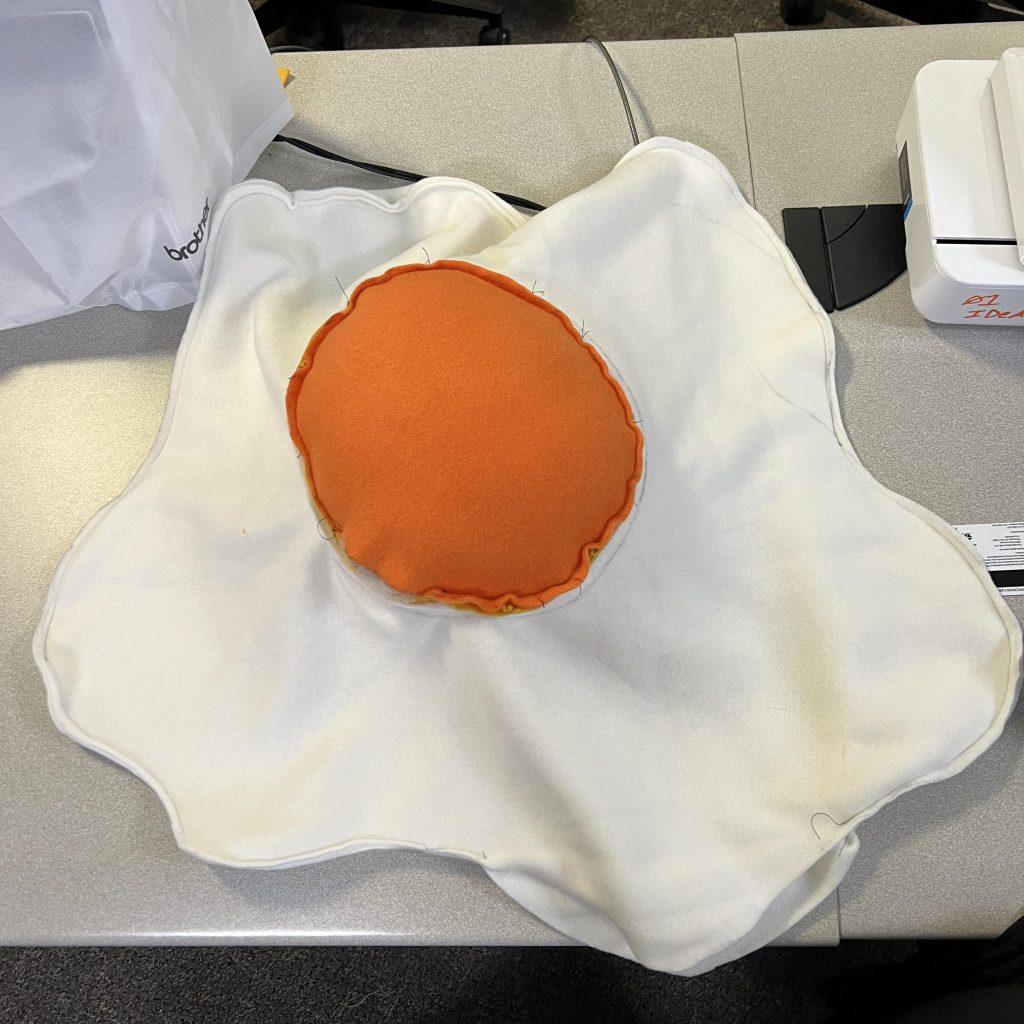
After flipping the egg inside out and imagining the next steps of filling, I realized that I did not want to fill the egg white portion as much as the yolk. To achieve a more filled yolk, I cut another circle from an orange fabric that would separate the yolk filling from the white filling. I sewed on the circle and filled the yolk very tightly. Then, I turned the egg inside out and filled the white until it was enough cushioning, but still quite loose and hand sewed the egg white shut.

peas in a pod
For my peas, I first started with two colors of green fabric. The lighter green, I cut into the tennis ball stencils. In our first sewing samples, we had to make two balls with different methods. From this, I learned that I could force the sewn shape to be not a circle, but an oval through different tension and speed on the sewing machine. I sewed all three peas and used polyfill to make them 3D peas.
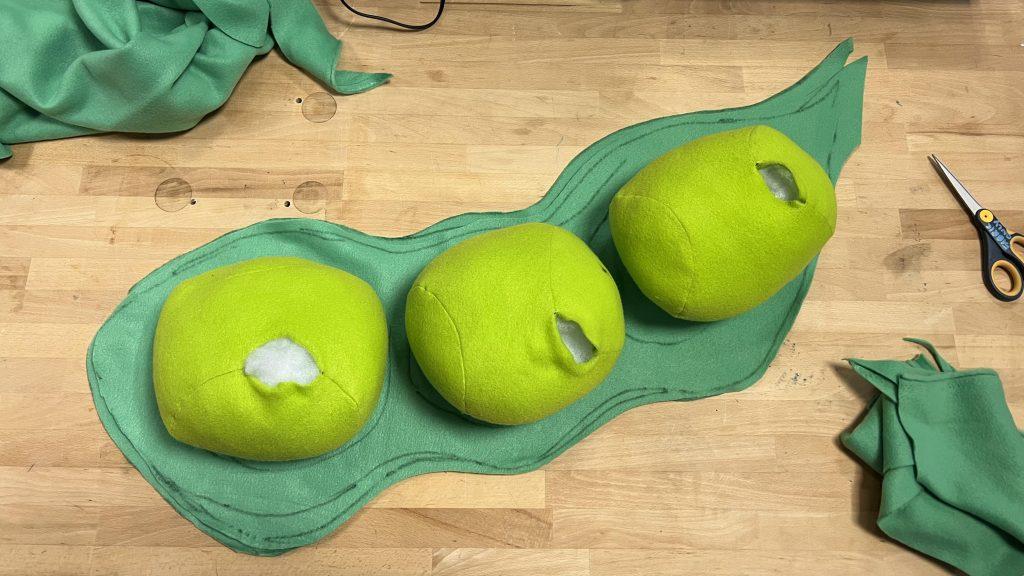
The next step was making the pod for the peas to lay in. I planned this step of the pods by drawing out a 2D shape on the darker green fabric, and estimated where the pockets for the peas to lie in would be by drawing three circles on the pod as well as a zipper for the pod to close and open to reveal the peas. After sewing one long edge of the two pod fabrics together, I flipped it inside out so the seams would be on the inside. Then I lined up each side of the zipper on the markings on the inside edge and sewed it on.

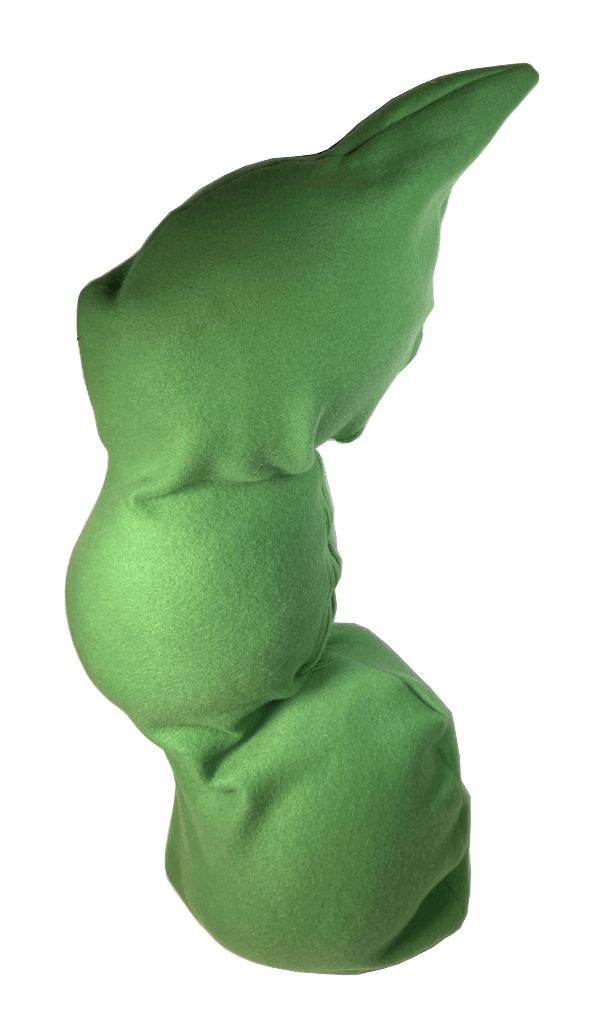
The challenge in this process was estimating how much fabric I would need to sew a pod that would fit the peas comfortably. After fitting the three peas into the pod and zippering it close, I found that the pod did not lay flat in areas I would have wanted it to. If I were to make another iteration of the pod for the peas, I would try to account for the bulge of the peas onto the pod and reinforce the edges of the pod to make the shape hold.
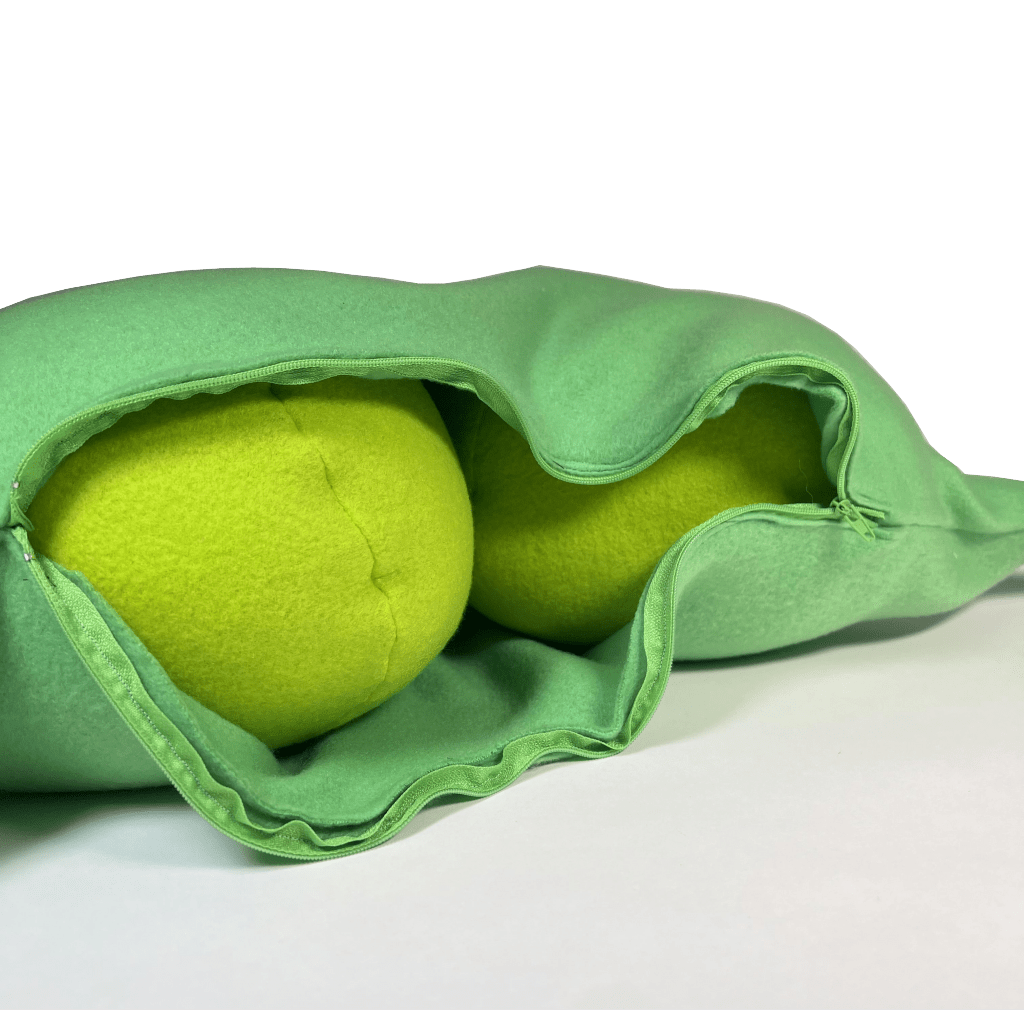
button
In planning my third object, I found that there were not a lot of fabric color choices. I had originally wanted three foods that I could construct to be large-scale as well as incorporate different techniques that I had not used before.
The button was a decision that came after thinking about donuts and bagels, foods that had holes. I spotted a button in my room and came to the conclusion that I would challenge myself with sewing four holes, not just one. My first iteration of the button started with two circle pieces of red fabric. I drew what I imagined would be the sewing lines and cut out the four holes for the buttons. I started by deciding to sew the small inner circles first, and then the outer circles. However, after completing hand-sewing the first inner circle, I realized that the button could not be flipped inside out- exposing all the sketches I had done on the fabric. I quickly started on my second iteration by preparing the fabric in the same method as I had done in the previous iteration. This time, I sewed the outside seam first with a small opening and then started hand sewing the small inner holes. Despite sewing the outside seam first, I still made the mistake of sewing the inner circles on the inside, making the button not able to flip inside out.
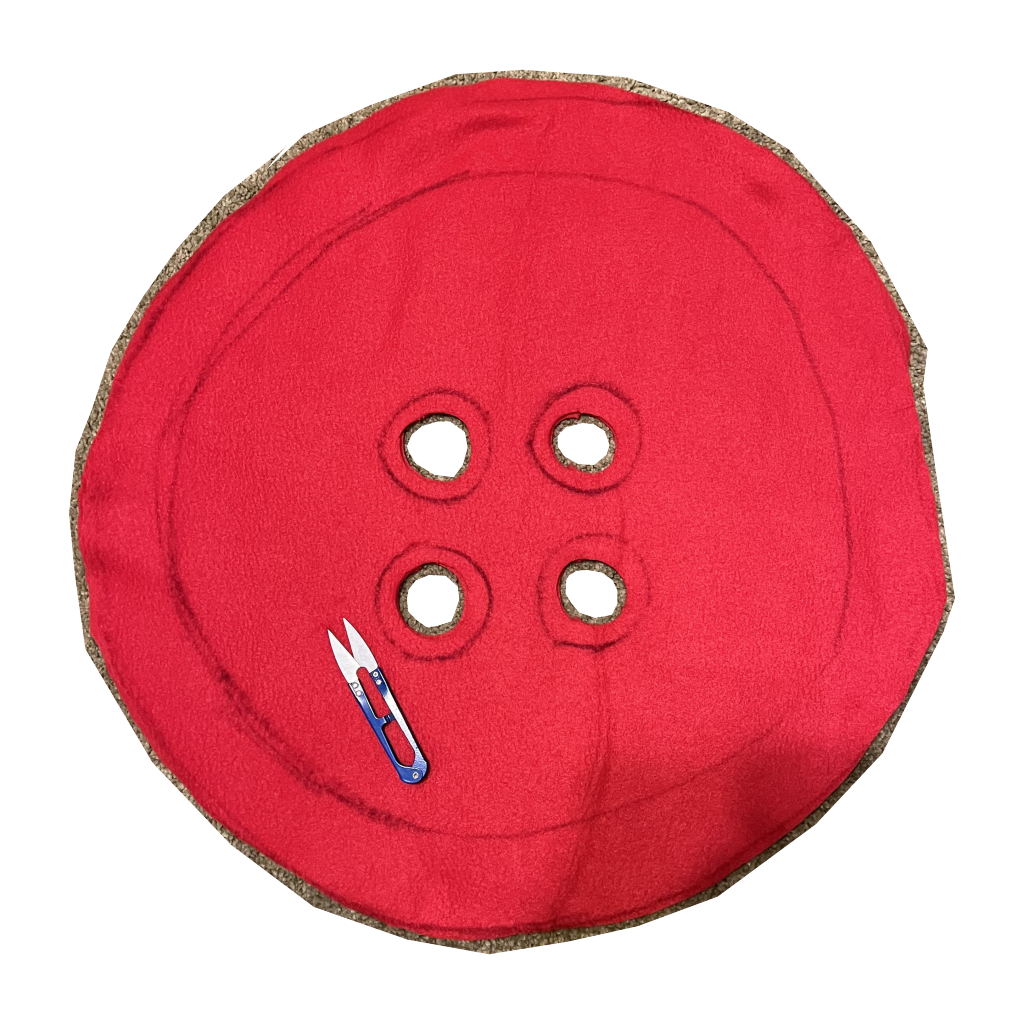
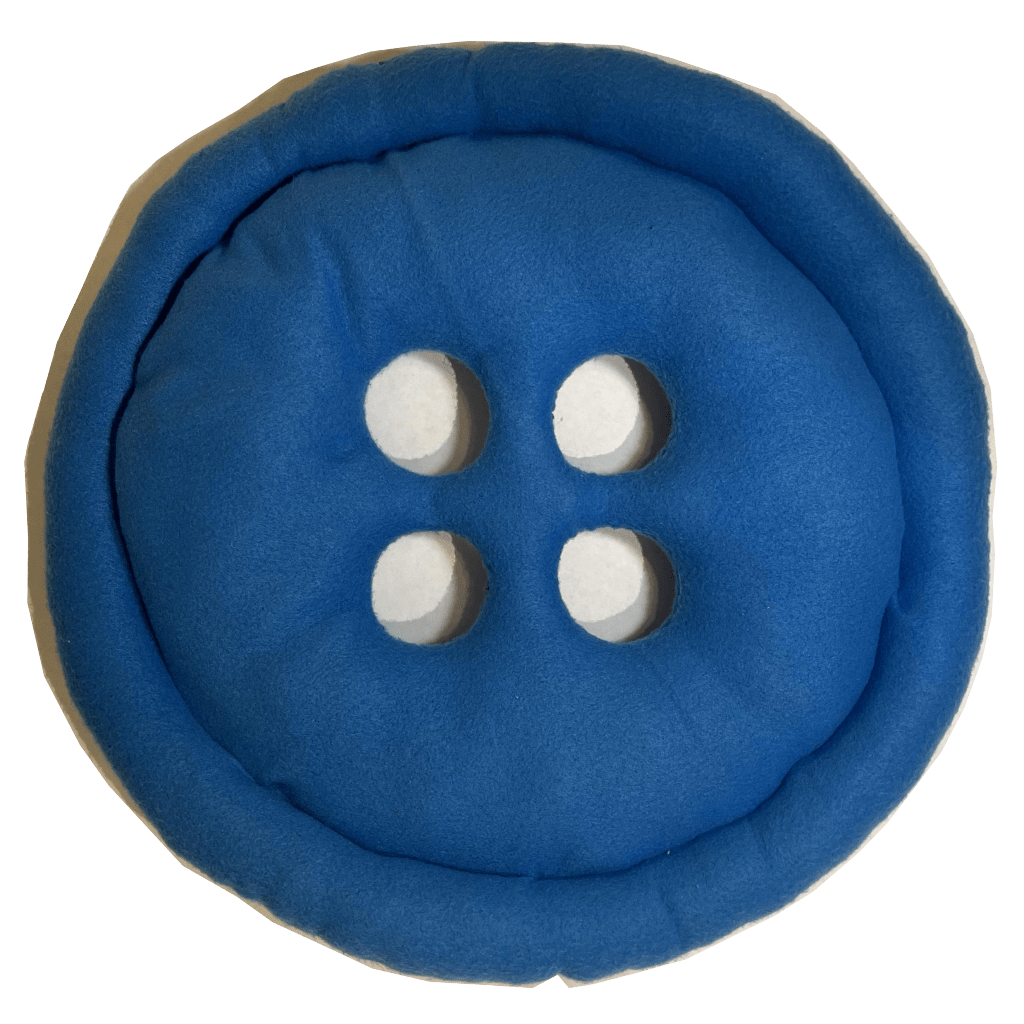
My third and final iteration of the button began with the same steps. But this time, I sewed the most outer portion of the button with an opening, then flipped it inside out so the seams would be on the inside. I decided to hand stitch to connect the two layers of fabric together and create the small holes in the button. Because I did not want my seams to have flaps on the outside, I learned how to do an invisible seam with a ladder stitch to close the fabric on the inner circles. While this was a tedious and time consuming process, I was very happy about the result and my newly learned skills.
After all four inner holes were sewn together, I stuffed the button with polyfill to reach the inner corners. Doing so, I found that the button puffed up more than I wanted due the edge of the button to the center having lots of space to fill. To make my button flatter, I removed some polyfill around the ends of the button and sewed a concentric circle 1.5 inches smaller than the edge. After most of the circle was complete I filled the insides loosely but tighter in the tubes around the inner four holes, then finished sewing the inner circle on the machine. This created a circular tube around the outer edge that I then bunched up to fill more easily. After filling it tightly, I used a ladder-stitch to close off the button.
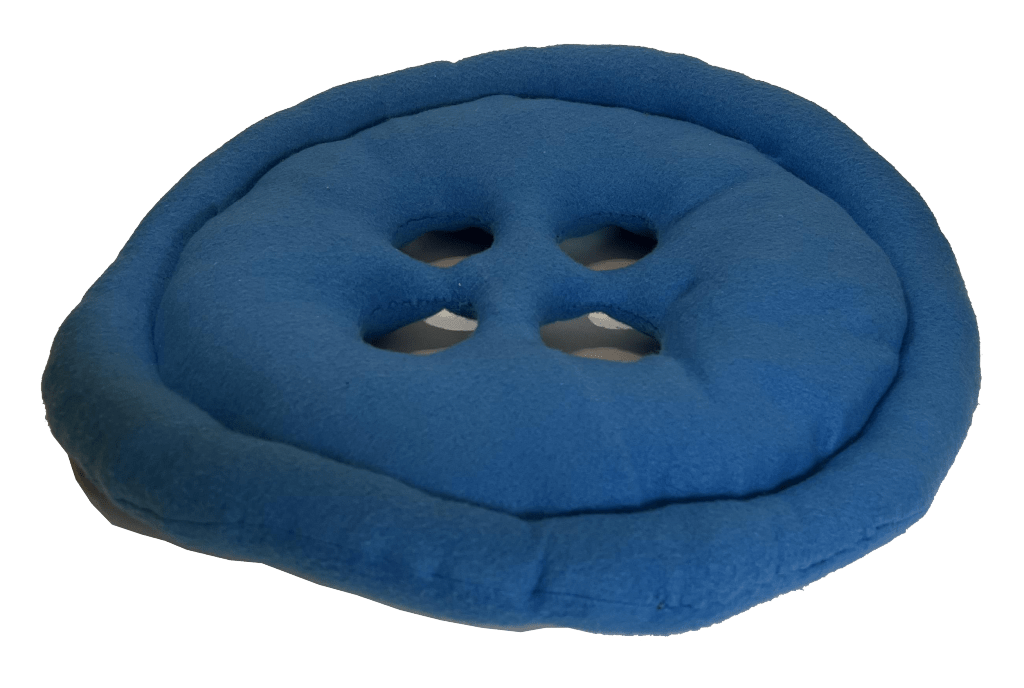
reflection on objects + process
Making the egg was less challenging than I had imagined, but a great first attempt at sewing without planning all the steps beforehand. I was able to find a solution for any problems I ran into, quickly and efficiently. Problem solving for the egg made thinking about a solution for my button much easier because I had to innovate from what I already had. The button was easily the most challenging object, but having so many iterations allowed me to think about sewing objects in a more detailed and orderly method. I will try this when I make another iteration of the pod for my peas.
improv inflatables (3) – junelee
I wanted to focus on creating regular and abstract shapes with explorations on connection methods using the vinyl heat press. The first inflatable is a square pillow, the second is an abstract blob, and the third is a triangular prism.

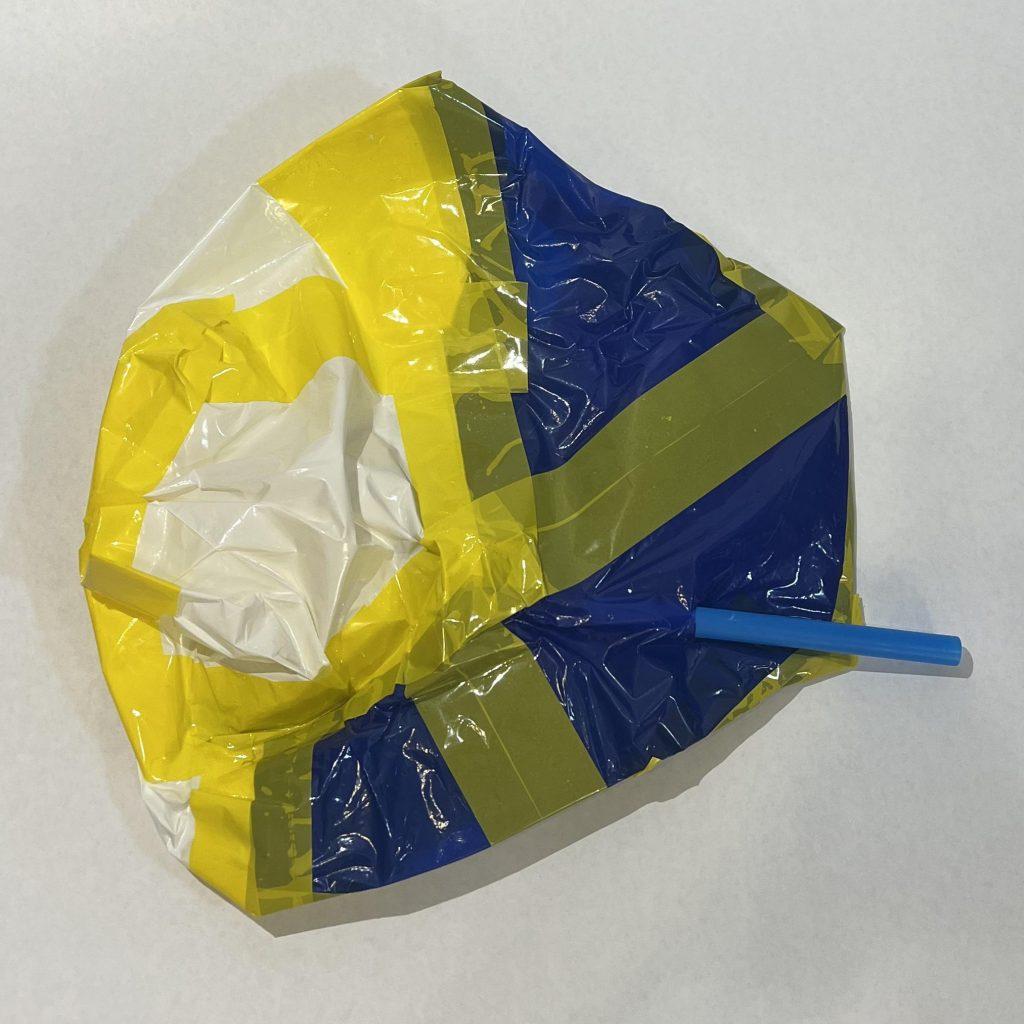
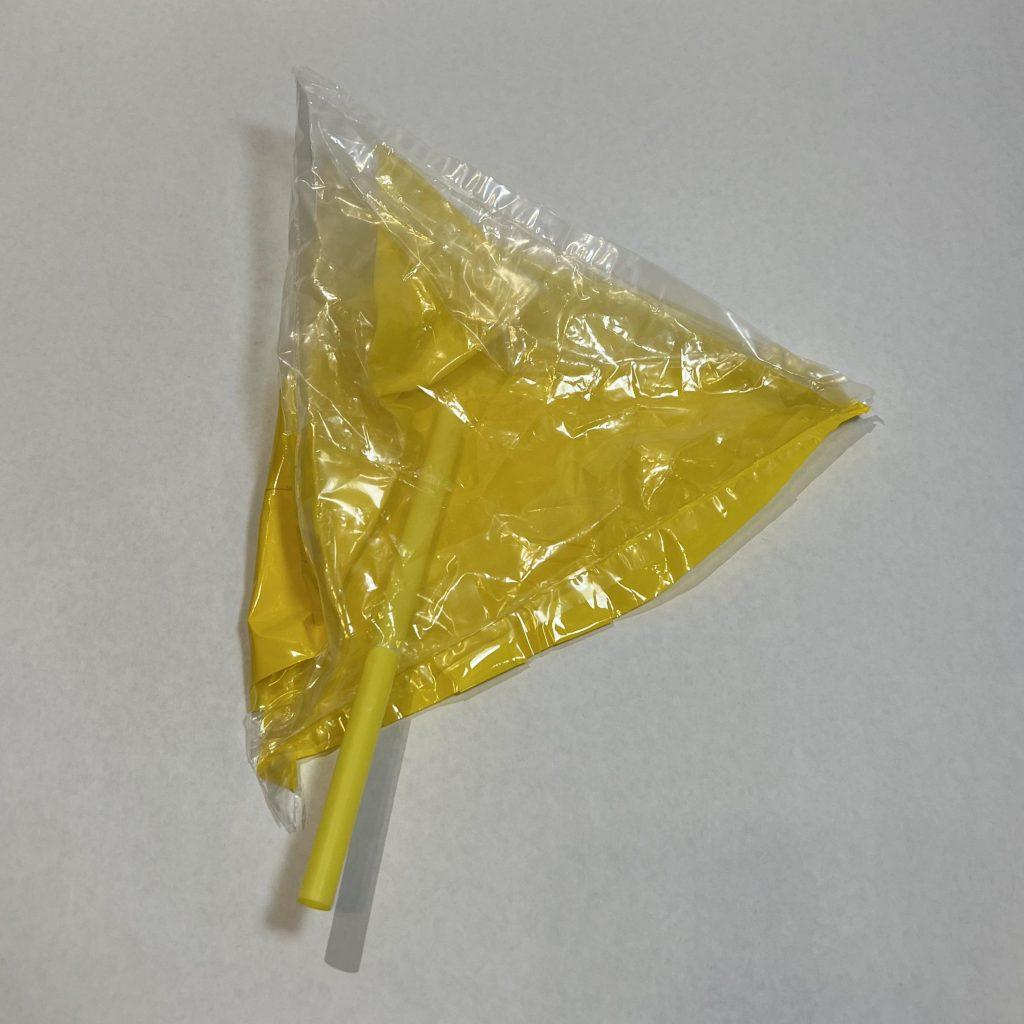
improv one
For my first one, I chose to use four corners of the given plastic vinyl bags and connect them together to create a 2D square. For three out of the four connections, I used the vinyl heat press to create hems on the inside, and for the last connection I used the same method for an outside seam. After connecting all four, I realized that there was a square shaped hole in the center due to how I cut the corners off the plastic bags. I cut a small square piece in clear and black to close the top and bottom with double sided tape on the inside of the inflatable.
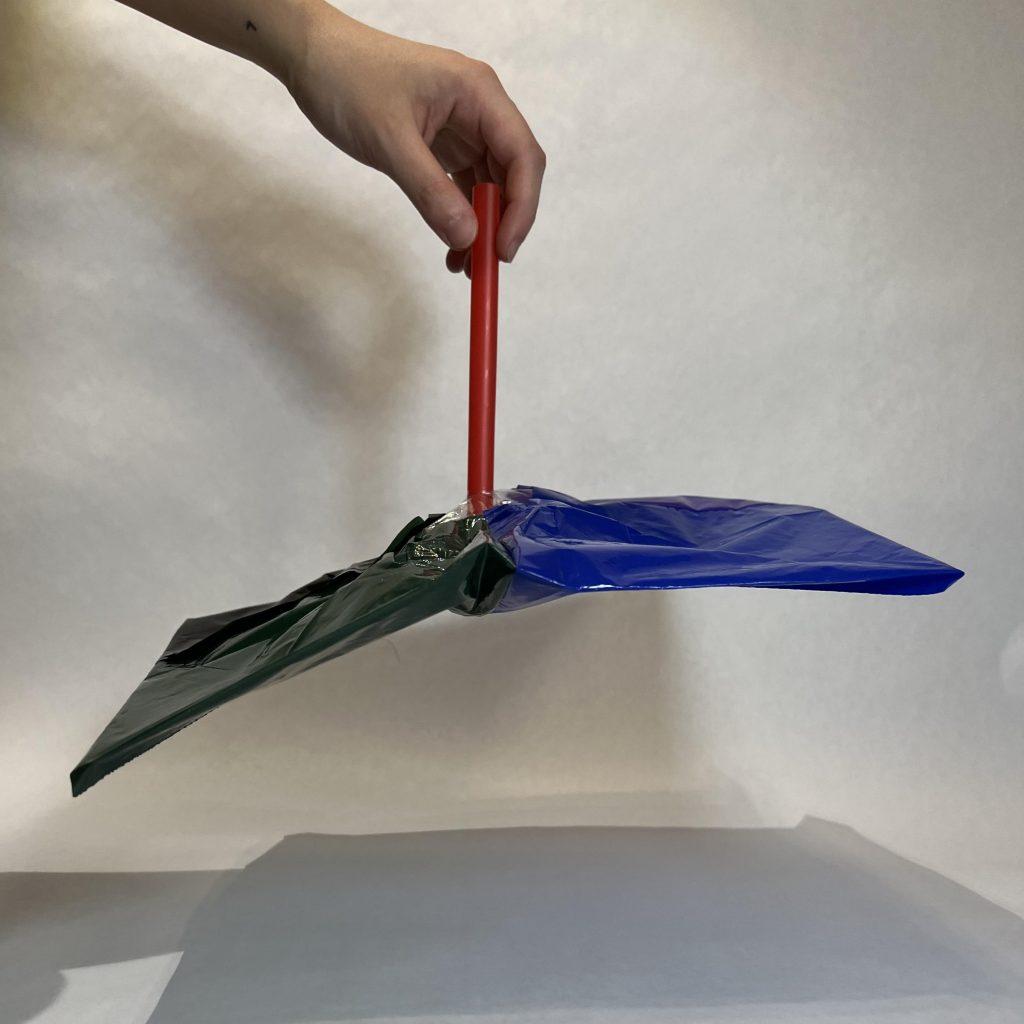

improv two
In my second inflatable, I found scraps from my classmate’s inflatable. I used pieces that were big enough and cut sides that were straight to match to another scrap. Choosing not to pay attention to the overall shape, I connected sides that were similar length with wide yellow tape. When the connected piece was big enough, I folded the piece to align the seams in a way that would create sharp edges in the inflated structure.
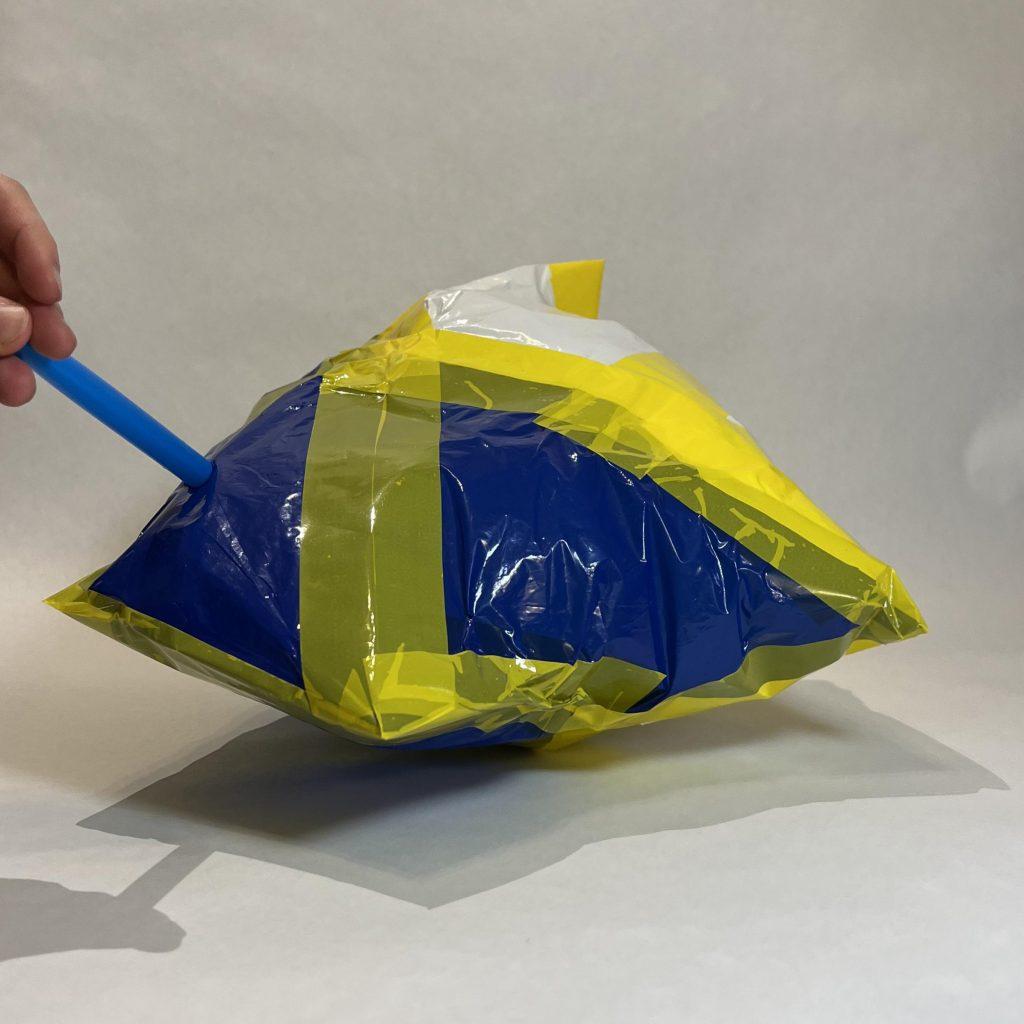
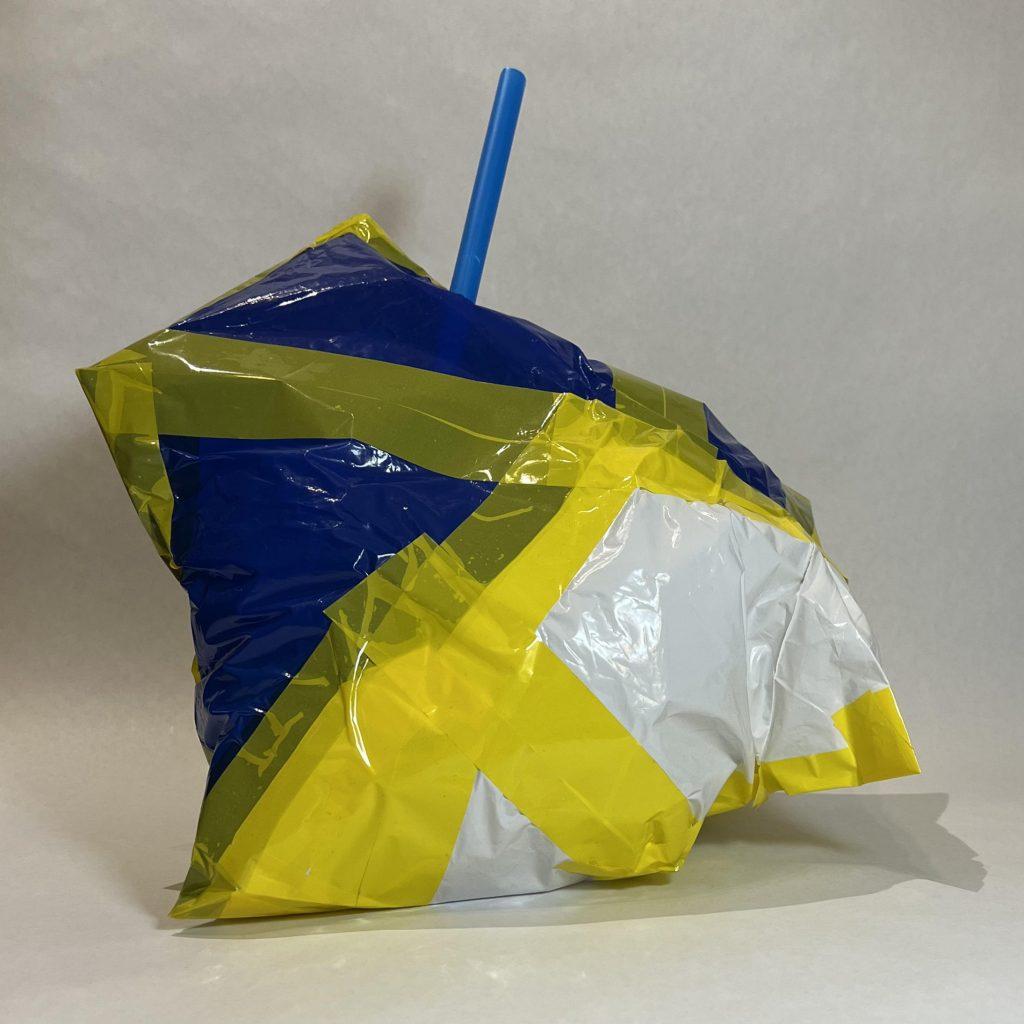
The challenge of this inflatable was closing the structure with edges that were angled in a way that could be attached without much excess. Because I did not want to manipulate the scraps much except some refined cutting, I had to keep improvising on where to connect the seams.
In this second improv work, I learned from those who were working near me. My classmate who was working beside me was finding many holes in her taped inflatable and I decided to make my third inflatable with the vinyl heat press, like the first one.
improv three
My last inflatable was made using clear and yellow vinyl plastic sheets that were heat sealed together. I wanted to create a triangular inflated structure as further exploration on geometric shapes, like my first one. To start, I cut one piece of triangle from a yellow sheet and two sheets from a clear plastic bag. I used a heat clamp to connect the three triangles with seams on the inside.
After standing it up in a triangular shape, I decided that I wanted the last triangle to be a bleed of both colors so I cut pieces from the scraps of the big triangles. I used wide yellow tape to join the clear and yellow pieces and create a bigger triangle. Using the heat clamp, I sealed the triangles together with inside seams except for the last.
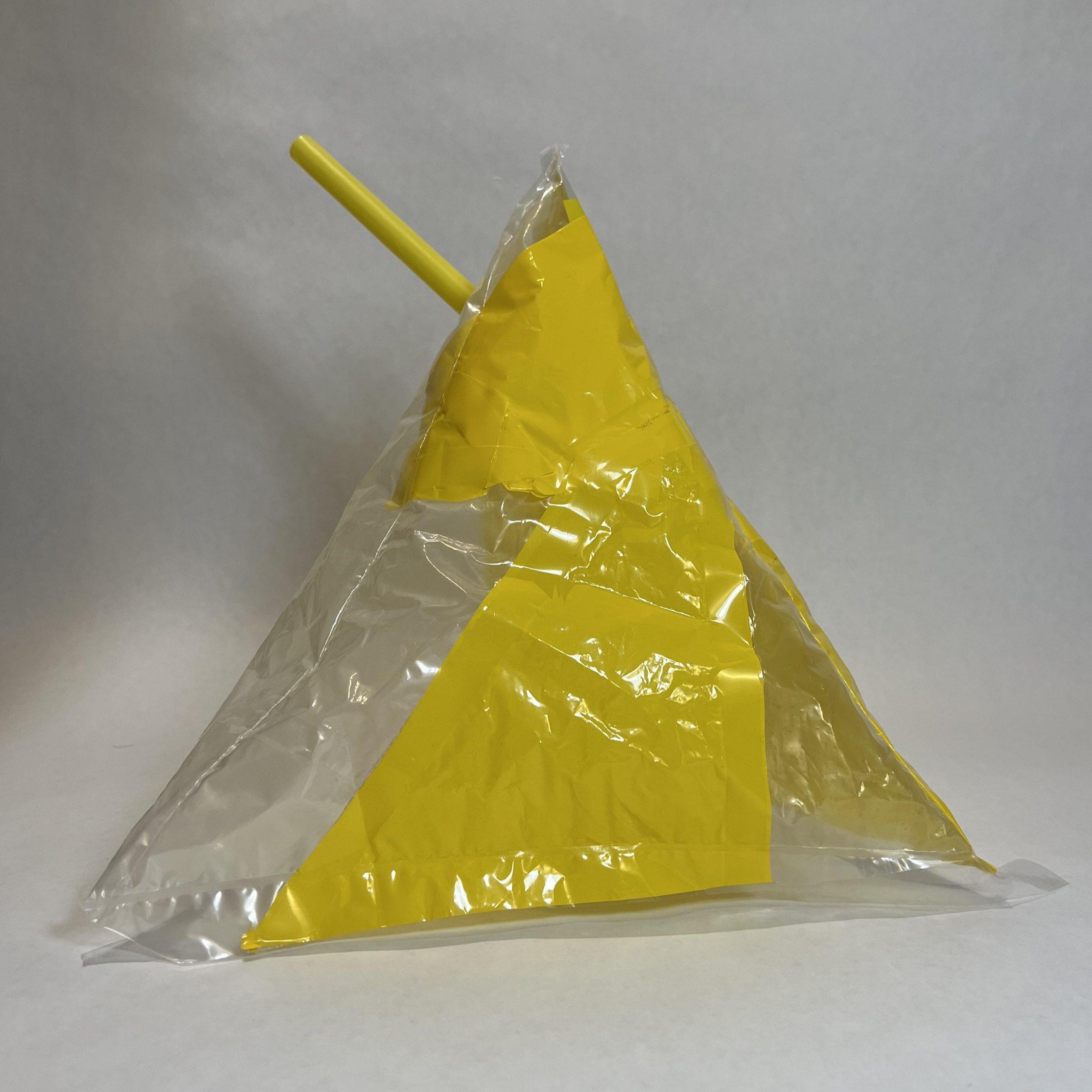
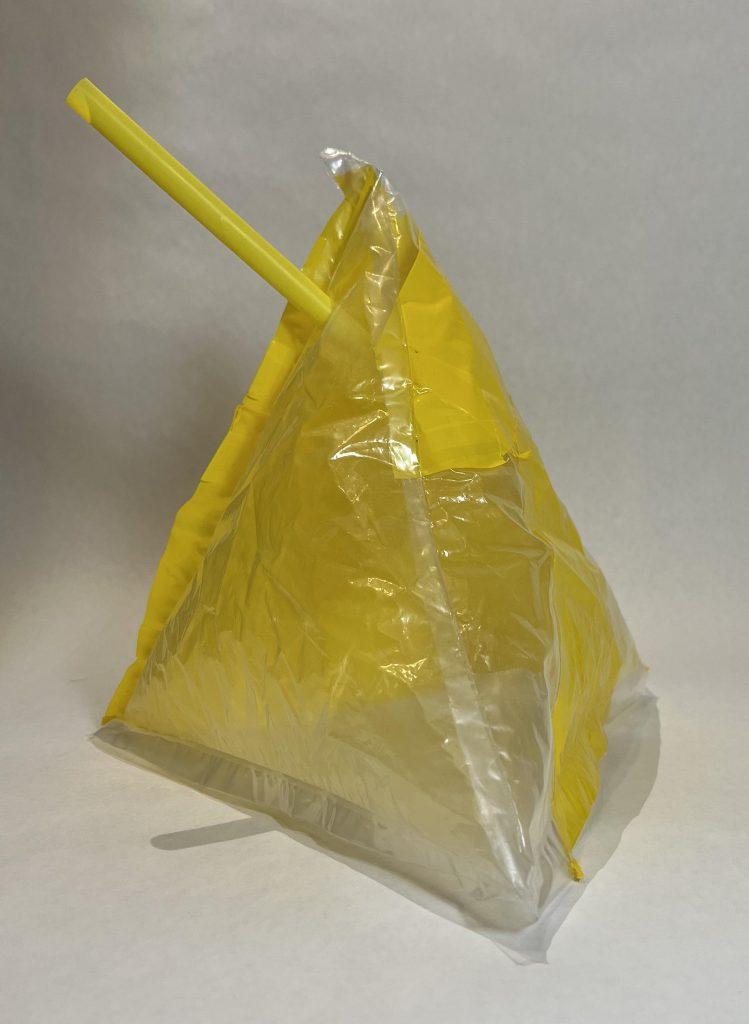
For me, this was the most successful improvised inflatable out of the three. It went according to my expectations and inflated to the triangular shape perfectly. I also found the inside and outside seams to blow up in different ways and found this to be something I want to further explore.
sewing practice (6)
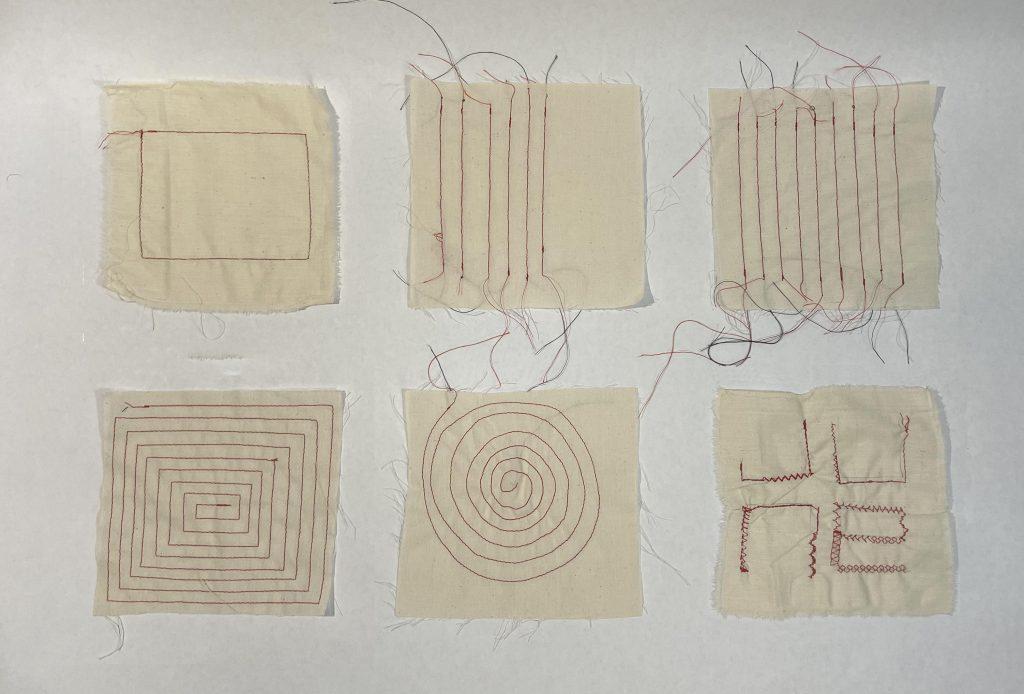
sewn sphere (2)
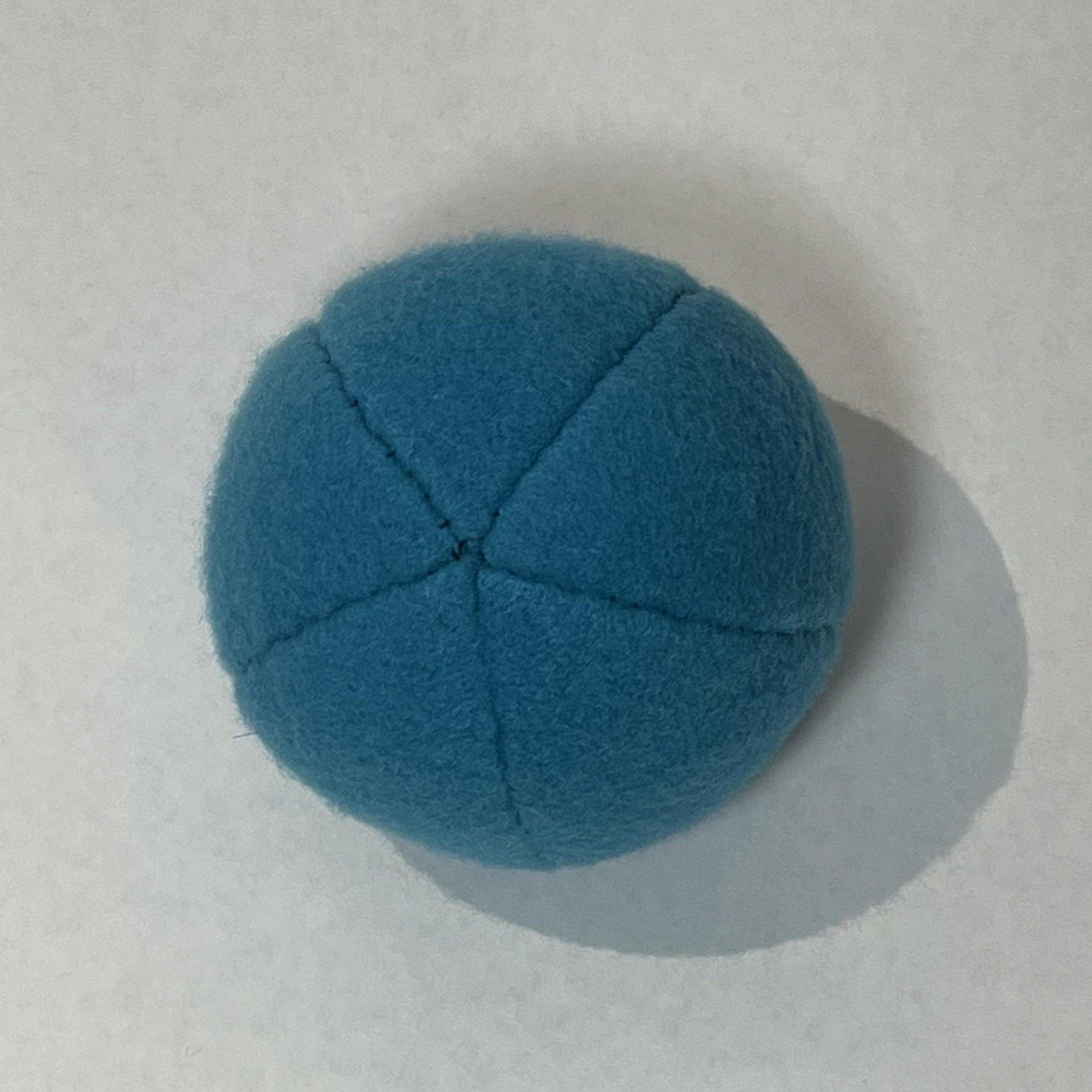
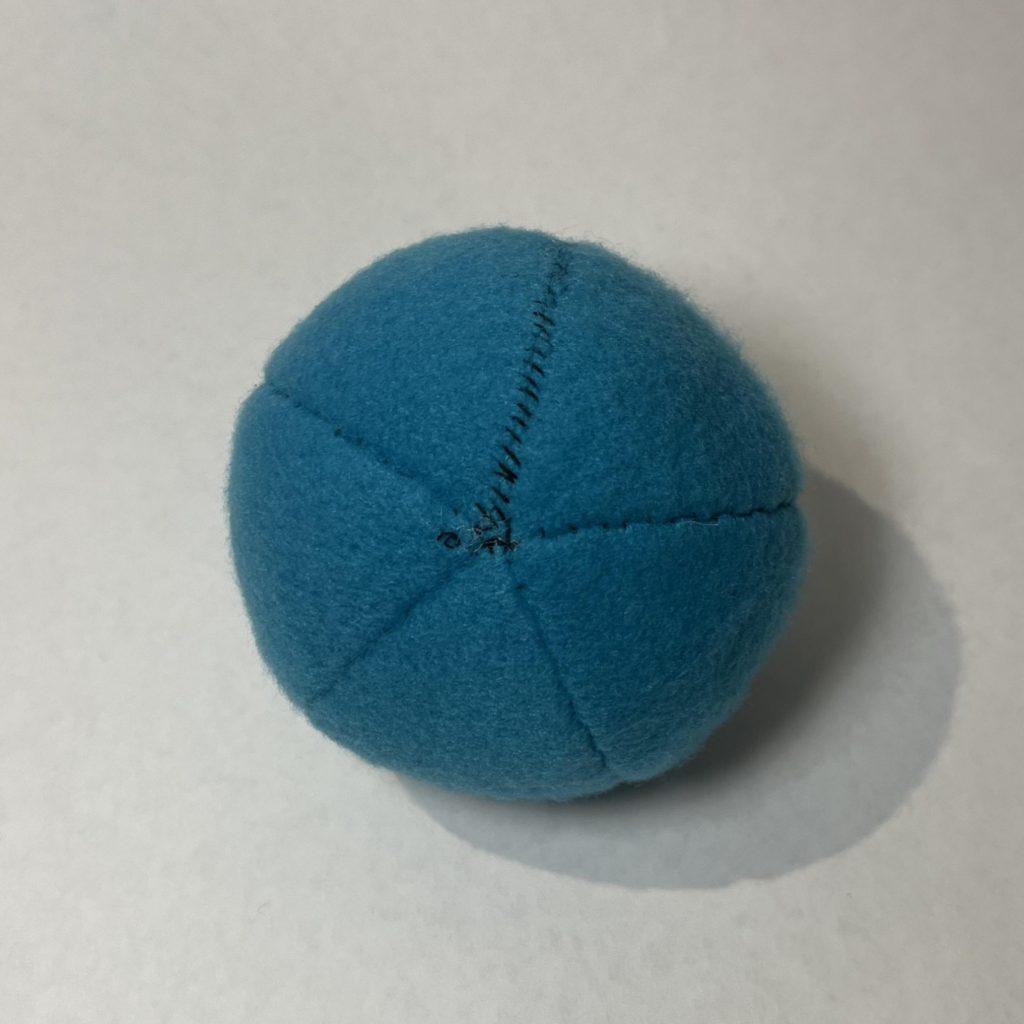
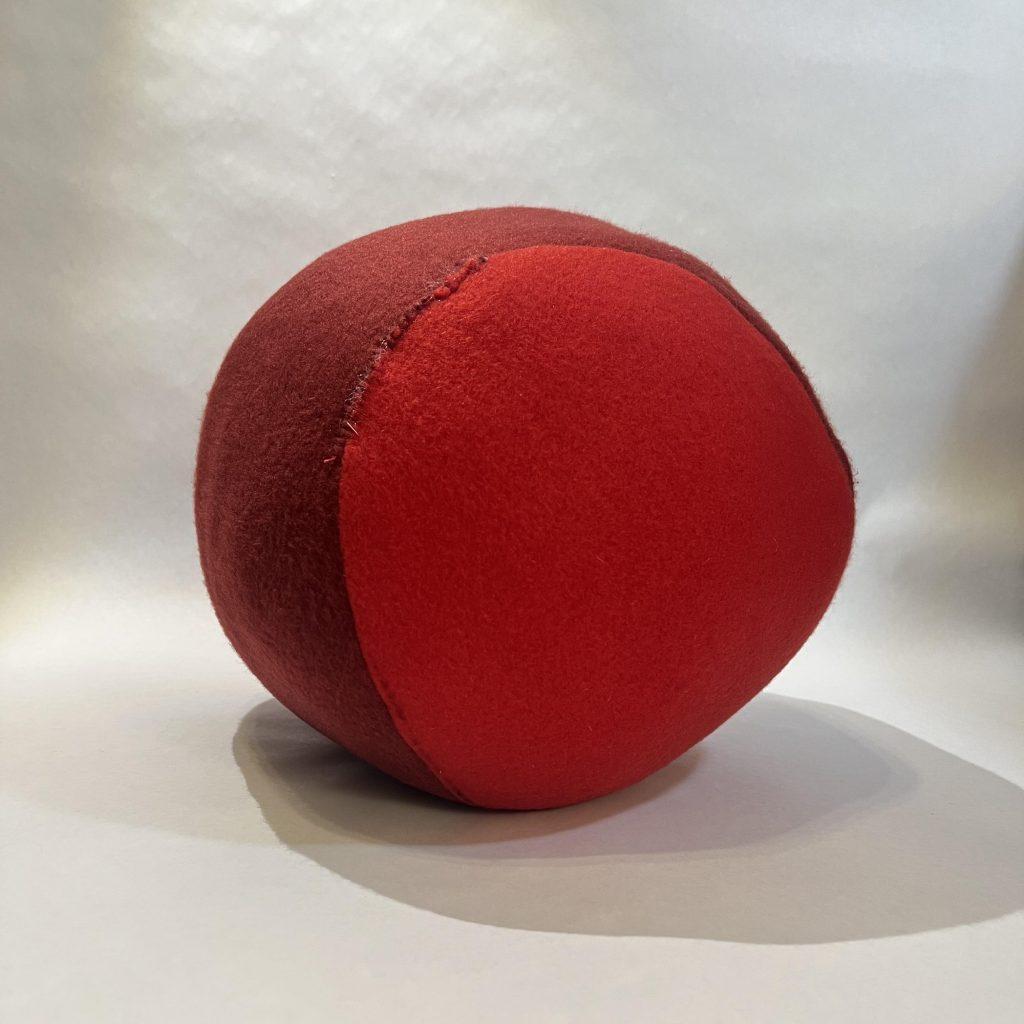
Final Project Details/Timeline: June, Elin, Neha, Adrienne
Proposed Timeline for Final Project:
4/3 – 4/7 : Finish muslin prototype, finalize patterns and overall vision of inflatable. Gather fabric needed for inflatable.
4/10 – 4/14: Finish laser cutting and dyeing pieces. If there’s time, begin sewing.
4/17 – 4/21: Sew inflatable and experiment with different embellishments (LED lights, flying parts within, etc)
4/24 – 4/28: Test with fan and make last-minute adjustments.
Materials Needed:
890 square feet of ripstock: all white
Colored Dye: red, blue, purple, yellow, green
Two fans, 12 sandbags
Final Project Details & Timeline – Mukundh, Graana, Adrienne, Edison
Timeline
April 3:
- Rhino model / Hand-drawn design
- Prototype
April 5:
- Completed unrolled patterns
- Finish testing to make sure inner wall tension plan works
April 10:
- Delegate tube sewers + main frame sewers
- Pieces cut
- Start dyeing
April 12:
- Individual pieces sewn
- Noodle arms
- Main cube structure
- Dyeing finished
April 17:
- Sew pieces together (as much as possible)
- Sew together the majority of the arms to the main structure
April 19:
- ¾ Sewn together
- Sew together all the noodle arms to the main structure
April 24:
- Sew entire inflatable together
April 26:
- Exhibition day
Materials & Tools needed:
Number of Fans
- 1
Colors of dye
- Black
- White
- Red
Materials
- Ripstop ½ ft of separation between walls
- 376 ft^2 of ripstop for the outside layer
- 50 ft^2 for connecting inside to outside walls
- 300 ft^2 of ripstop for inside layer
- 100 ft^2 of ripstop for roof
- 81 ft^2 of ripstop for ceiling
- 9.5 ft^2 outside layer + ~9 ft^2 inside layer (x6 noodle arms)
- 3 ft^2 for outside hand layer + ~2.5 ft^2 for inside hand layer (x6 noodle arms)

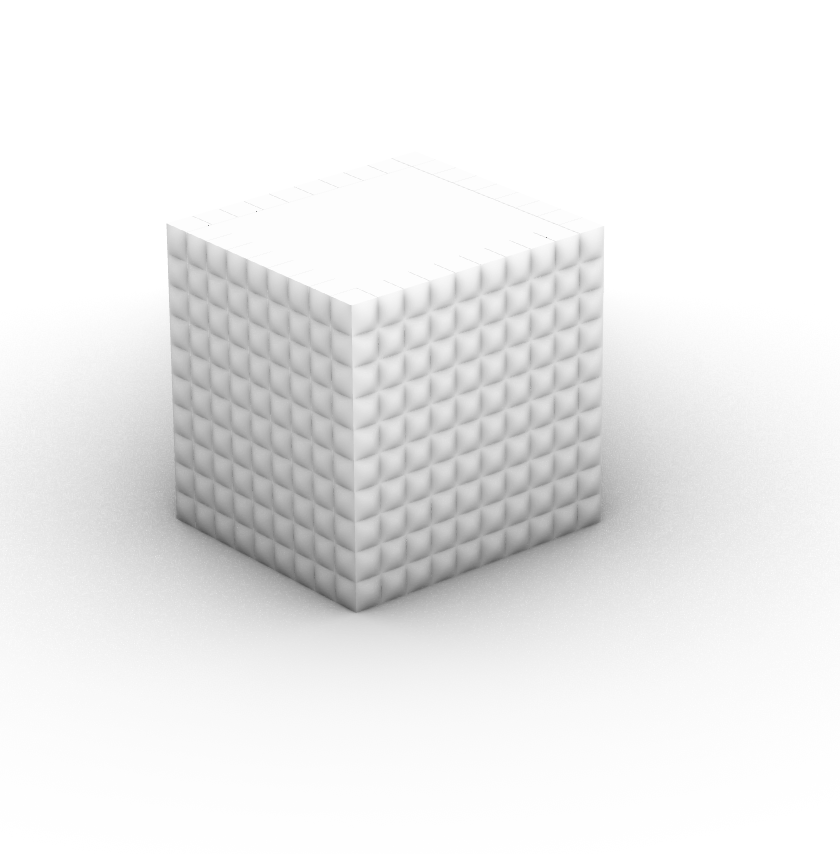
Landscape Proposal | Bridget, Tracy, Elisa, Jamie
We want to create oversized jewelry as a landscape

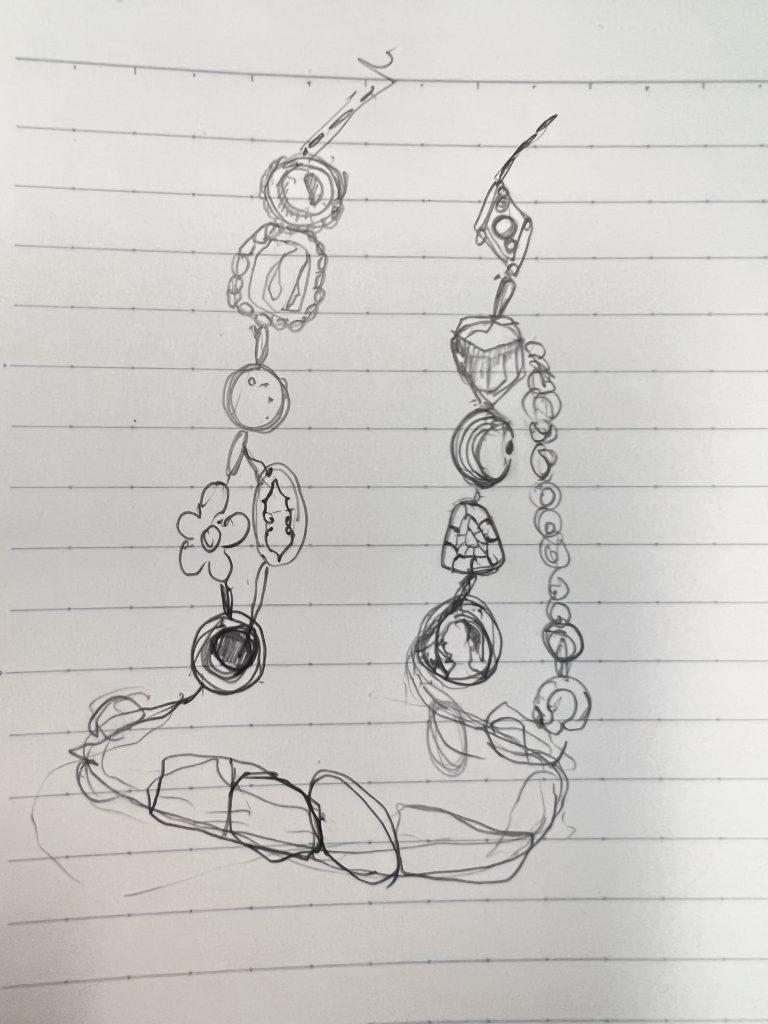
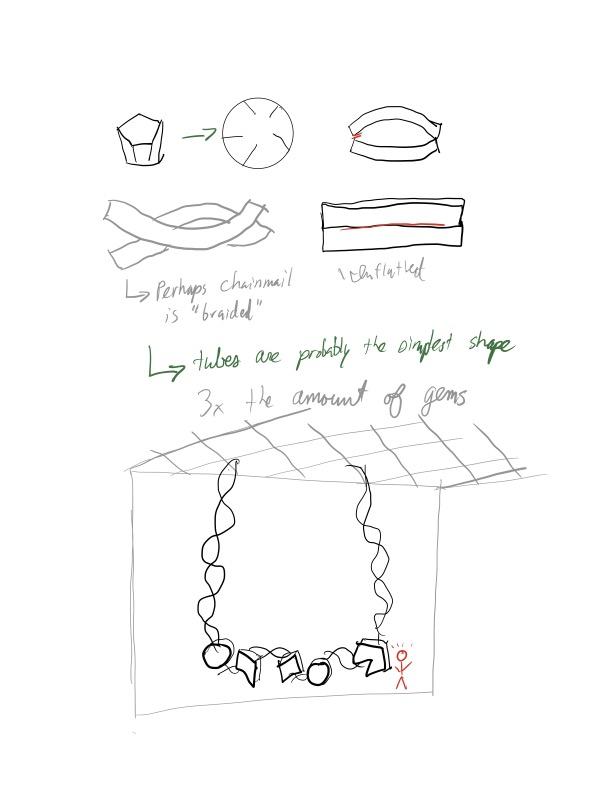
DESCRIPTION
For our final landscape proposal we envision a large scale necklace which hangs from the ceiling. We wished to create an inflatable that felt inviting, interactive, and playful. We imagine that depending on how the jewlry is hanging from the ceiling, people would be able to traverse the space that is defined by the jewels, additionally, there would be a beautiful ground condition where the jewelery piles on the ground. The hope is that this design in execution would allow for play, touch, and occupation.
The jewelry would have to be long enough to have an effective draping technique that can define the spatial experience of those who near it. Additionally, by creating an inflatable chain, we have the ability to create charms that are attachable and can add a sense of depth to the design, as well as shape the visual form.
MATERIALS
- Various dye
- 75 yards of white fabric (for dying)
- Velcoros
CONNECTIVITY
Due to the nature of the contraction flow, each person will craft and design jewelry pieces/charms individually and then assemble them at the end, For the necklaces to read like a piece of wearable giant jewelry, the chain portion/connectivity is very crucial. We are concerned about the chain’s dimensional compared to the gem/charm will be difficult to inflation ie: air is not able to travel through the thin tube to the large mass and inflate the gem/charms. Thus we would need to schedule more time toward the end of the fabrication stages to be ready to run into problems and readjust.
ORIENTATION/POSITION
We would like to hang our inflatable from the ceiling so we would need to figure out the position of the fan and its direction at the site.
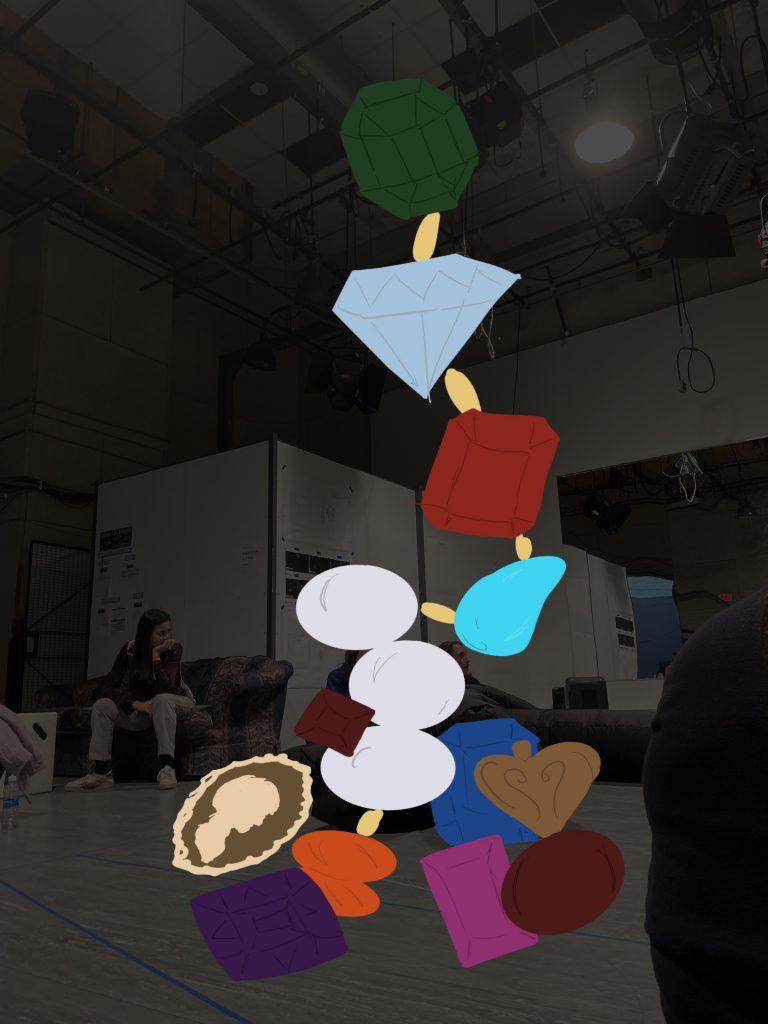
Final Project Proposal – Mukundh, Edison, Graana, Adrienne

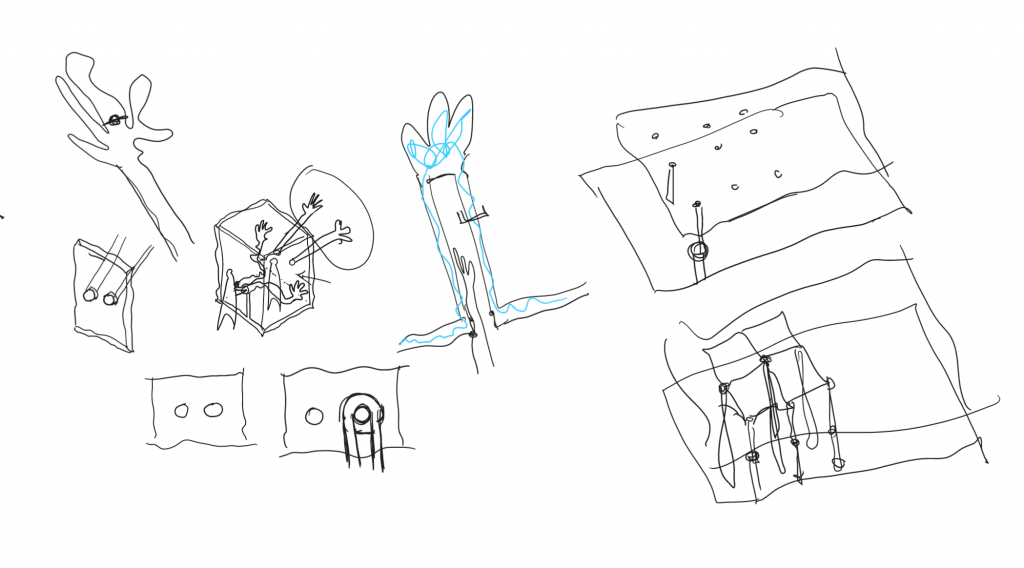
For our inflatable, we chose to make a double-walled cube, with two layers of interactivity. Our inflatable structure will have exterior and interior features with which people will be able to interact with. On the outside, people will be able to use glove-like inflatables that enter the inflatable through the walls in order to interact with people inside the inflatable. The same experience will be available for people on the interior. In order to enter and exit the interior portion of the inflatable, people will be able to enter the space through a main entry point and walk around interacting with the gloves, which are being moved by the people outside the inflatable. They will also be able to move the interior gloves in order to interact with the people in the exterior. The overall feeling is to exhibit the “Death of Isolation” with landscape images projected/dyed on fabric and through a feeling of distance and separation created by the exterior and interior layers of the structure.
Ideally, we would like people to be able to have sudden interactions with people on the outside, or when they’re outside, to have interactions with people on the inside, to mimic social interactions, but at the same time have a large enough space for everyone to lounge, while being 6 feet away from each other. This concept is motivated by the theme “Death of Isolation”, and to showcase social interactions in a new world. Our choice of landscape is a post-COVID world, when people are trying to have more social interactions, while still highlighting the struggles of the socially limited society we experience during COVID.
There will be one fan on the outside corner, which will inflate the entire structure. We are also thinking about maybe having the fan on the inside to give it a more clean exterior appearance. In terms of the structure, we chose to use a double walled cube as our main structure. The walls will be brought together across different points within the inside of the wall in order to create different textures on the exterior and interior of the structure. We will be adding different openings for our glove-like feature at different points across the interior and exterior surfaces. The gloves will also be double layered in order for them to remain inflated at all times.
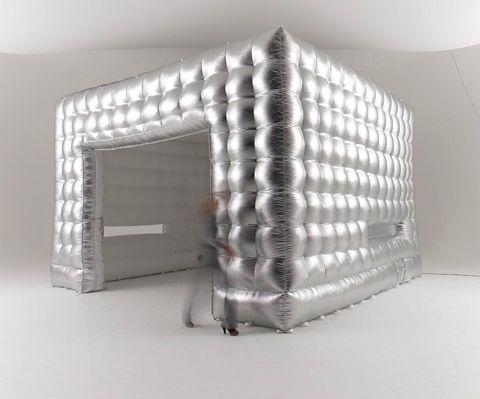
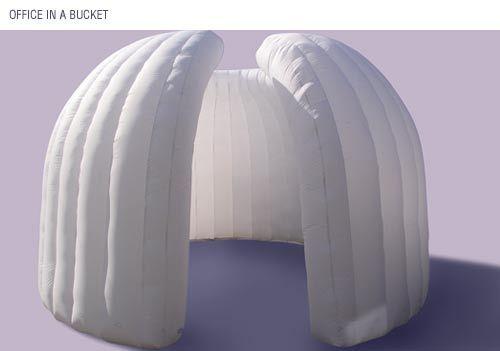

Final Project Proposal – Adrienne W, Elin Z, Neha C, June L

For the final project, our group’s idea is to have a rounded, tunnel structure that has an outside and inside layer. Ideally, the animation projection would be displayed on the inside layer of the tunnel so when people walk through the tunnel, their silhouettes can be seen on the outer layer. The inflatable would resemble a multi-faceted interactive landscape with different displays, allowing the audience to interact with it in different ways. We anticipate the inflatable to be approximately 7 feet tall and 5 feet wide. We expect to use a translucent fabric for the outside layer and most likely ripstop nylon for the inside layer.
There may be several challenges throughout this project, including maintaining the curved structure of the inflatable as it is inflated and expanded with air. To ensure this inflatable has the intended structure, the pieces patterned will need to be in smaller sections and account for the expansion into a rounder shape when inflated. Another challenge will be making sure a person can fit under the structure both in height and width, especially after the two walls are connected and curved at the top of the structure. We will be modeling this structure with real dimensions before patterning to make sure it can be walked through. Finally, we need to test that sewing together two different types of fabric with different opacities can still be robust when inflated, and that the seams will look clean and intentional.
Jocelyn, Jasmin, & Summer Landscape Proposal
Our idea is to have a dome with tentacles of spheres inside. The dome will be either plain (white or gray) or black and white tye dyed. The inside of the dome will be a surprise. It will have lots of colorful tye-dyed tentacles and potentially space-themed objects. The animators will animate either on the inside of the dome or on the outside of the dome, hopefully, they will make space-related animations. We will have a carpet of sorts inside the dome. We will maybe add magnets or velcro into the tentacles for people to customize the landscape as an interactive element. Otherwise, we will have long tentacles that people can gently move around and push around the space. Hopefully, a penguin (inflatable) will greet visitors outside.
We will need a large amount of white ripstop nylon. We will need dye (in various colors). We will need to use a laser cutter. We will potentially want a carpet or carpet-like fabric for inside the dome (10 ft diameter).
The most challenging part of our idea would be conceptualizing how to construct the dome. We definitely will need to ask what would be the best way to approach it since we are not positive if our idea would actually be functional and blow up/stand the way we want it to. Our initial thought for how to approach the dome is to make two half sphere shaped layers (with the inside one being slightly smaller and outside one being larger, so there’s a gap for air to fill in between).
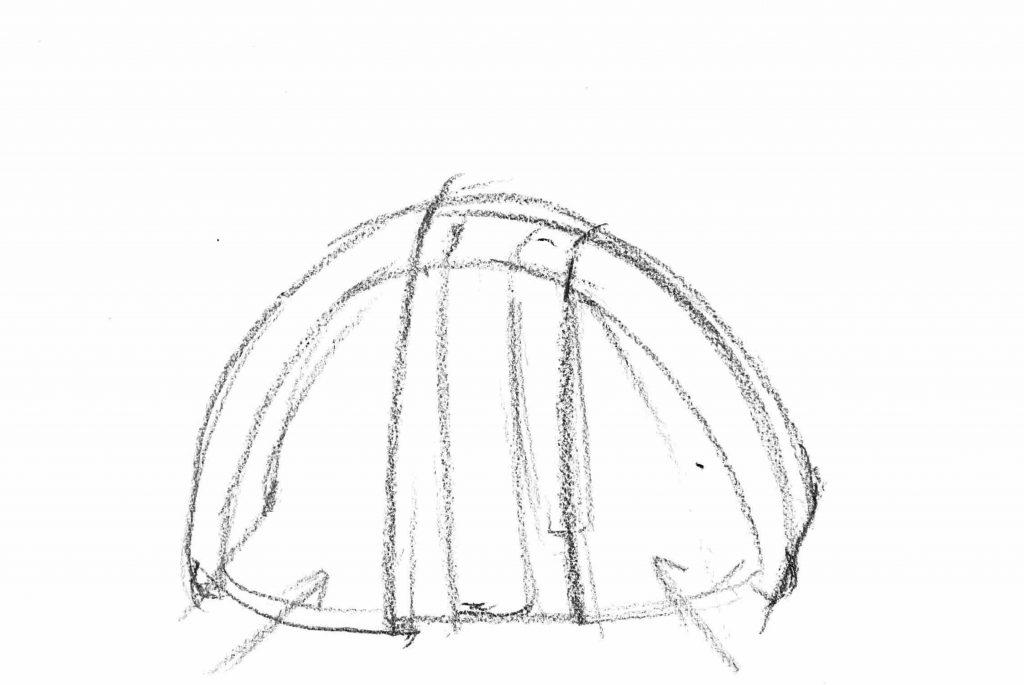
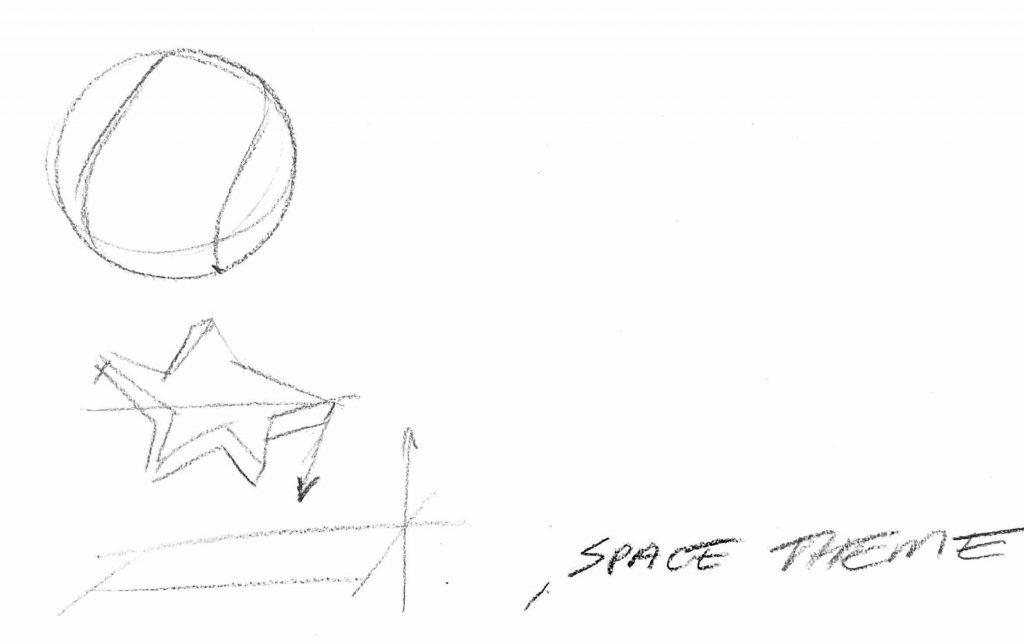
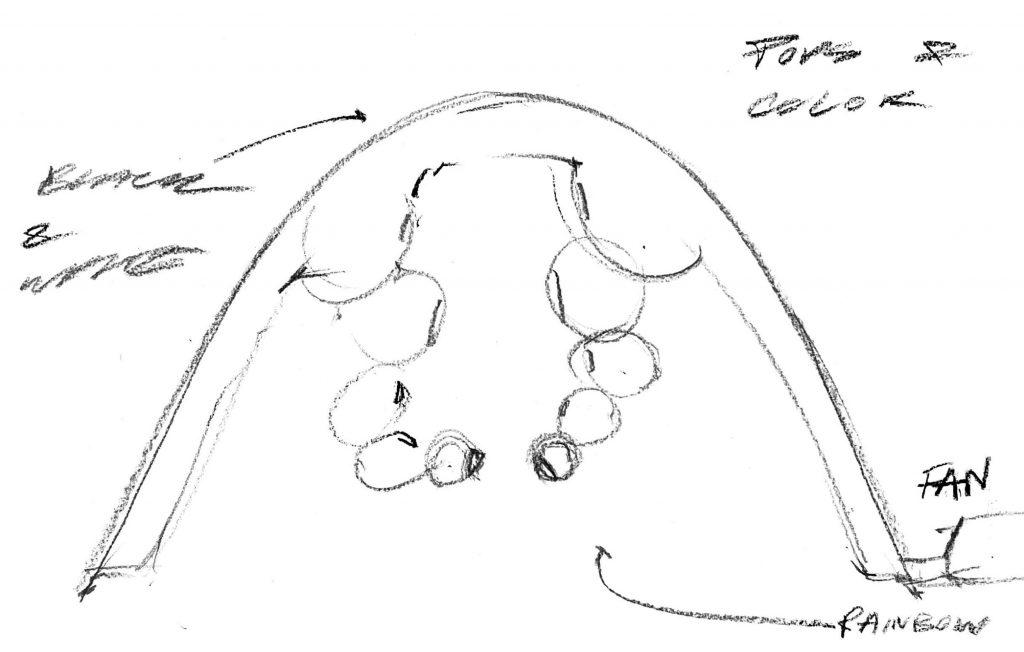
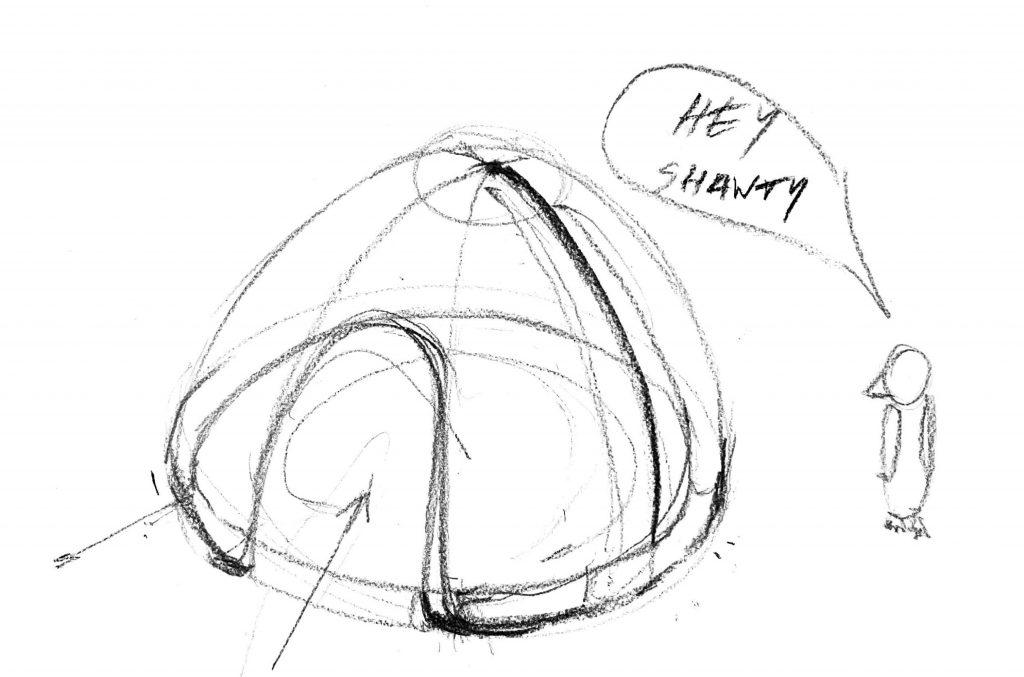
4/3 Update:
- \Make a timeline with bench marks of what you need to accomplish by when.
- Include: patterns, dyeing, prototypes, cutting, sewing, testing, finishing, and anything else you will be doing in the process.
4/3 Finish Timeline & Calculate Materials
4/5 – Complete patterns and prototype of difficult element
4/10 – finish laser cutting
4/12 – finish dyeing
4/21 – tentacles done
4/24 – aim to be roughly done
4/26 – rehearsal (?)
April 29th – Exhibit
- Calculate the materials & tools you need:
- how many yards of White or Black ripstop you expect to need
- what colors of dye you need
- how many fans you think your project will need
Dome – 314.16ft^2
Tentacles – 19.63 ft^2 (7 with these surface areas; 2.5ft diameter) + 7.07 ft^2 (7 of these; 1.5 ft diameter) + 3.14 ft^2 (7 of these; 1 ft diameter) + 0.79 ft^2 (7 of these; 0.5 ft diameter) = 214.41 ft^2
Total = 528.57 ft^2 => if the fabric has a width of 3.75 ft (45 inches) then the length of fabric we would need would be 140.95 ft or approximately 47 yards of fabric
We assume that majority of the fabric would be white ripstop nylon (probably
Red, Orange, Yellow, Green, Blue, Purple, Pink
Projector on the ceiling (?) onto the outside – stars (?)
We will only need one fan.
